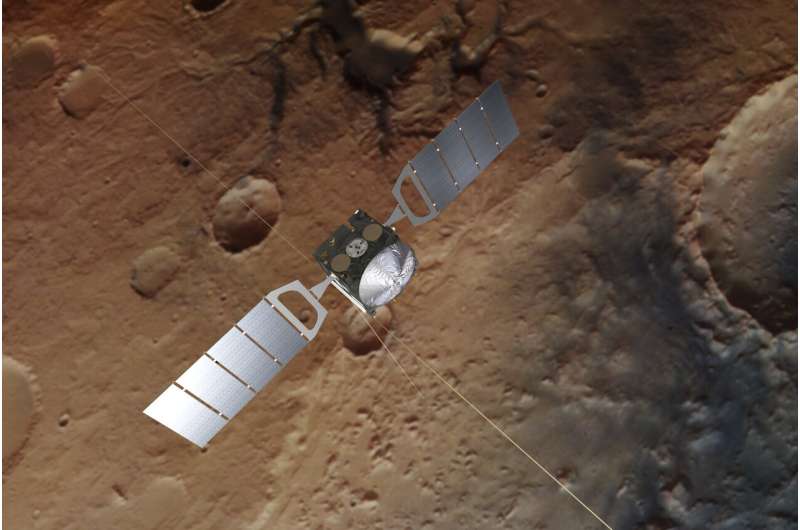Unique use of ESA spacecraft ‘housekeeping’ data reveals cosmic ray behaviour

Using data originally gathered for spacecraft ‘housekeeping’ aboard ESA’s Rosetta and Mars Express missions, scientists have revealed how intense bursts of high-energy radiation, known as cosmic rays, behave at Mars and throughout the inner solar system.
Housekeeping data are gathered by most spacecraft and components, and is used by engineering teams to monitor spacecraft health and diagnose faults (by logging parameters such as component health and ‘on/off’ status, for example). Such data could be linked to scientifically interesting phenomena, and so represent a valuable science resource that remains mostly unexplored.
Objects in space are regularly hit by charged particles that stream in from the wider Milky Way, including cosmic rays. Cosmic rays can cause electronic damage if they hit space hardware and threaten human health on crewed missions to Earth orbit, when astronauts are less protected from radiation by our planet’s atmosphere. The threat posed by cosmic rays will be even greater for crewed missions that will venture further into space, for example to the Moon and Mars.
To keep tabs on spacecraft health, space missions log when cosmic rays hit an onboard computer and cause memory errors—something known as Error Detection And Correction, or EDAC.
“Mars Express has been collecting these measurements since launch. We accessed data collected since 2005, giving us an amazing 15-year dataset spanning almost the entire mission lifetime—a real rarity,” says Elise Wright Knutsen, lead author of the new study, formerly a trainee at ESA’s European Space Research and Technology Centre (ESTEC), and now at LATMOS/IPSL, France.
Using data originally gathered for spacecraft ‘housekeeping’ aboard ESA’s Rosetta and Mars Express missions, scientists have revealed how intense bursts of high-energy radiation, known as cosmic rays, behave at Mars and throughout the inner solar system. Credit: ESA/Data based on Knutsen et al
A few factors influence the intensity of cosmic rays we see in the solar system, including where we are in the sun’s periodic 11-year activity cycle, and distance from the sun. “We were able to explore the sun-cosmic ray relationship in detail thanks to EDAC data from two prominent ESA missions: Mars Express and Rosetta,” says Elise. “This is the first time EDAC data have been used in this way—it’s been used before to explore short-term solar events, but never in the longer term.”
Elise and colleagues used EDAC data from the two missions to characterise how cosmic ray behaviour changed throughout our sun’s cycle of activity at Mars (by comparing Mars Express EDAC data to corresponding data on sunspots and from Earth-based monitoring), and to reveal how the amount of cosmic rays detected in the inner solar system varies with distance from the sun (by comparing EDAC data from both Rosetta and Mars Express). Rosetta orbited around the solar system for 10 years—at its farthest reaching beyond the orbit of Jupiter—before arriving at its target comet, collecting data over a wide range of distances from the sun.
“We found that cosmic rays behave very similarly with respect to the sun at Mars as they do at Earth, and are strongly influenced by the solar cycle,” adds Elise. “As the sun grows more active and hosts more sunspots, we see fewer cosmic rays, as our star deflects more of them. However, this ‘anti-correlation’ is seen around 5.5 months later—it isn’t immediate—and the reason for this time lag remains an intriguing open question.”
Comparing the EDAC measurements from Mars Express and Rosetta also showed that cosmic ray counts increase by around 5% per ‘astronomical unit (AU)’, with one AU being the distance between the Earth and the sun.
In situ data, especially science data, is rare in much of the solar system, and observations of the radiation around other planetary bodies are relatively sparse. Although spacecraft do not carry out routine science observations as they cruise through space en route to their destination, they are always collecting housekeeping data.
Artist impression of ESA’s Rosetta approaching comet 67P/Churyumov-Gerasimenko. The comet image was taken on 2 August 2014 by the spacecraft’s navigation camera at a distance of about 500 km. The spacecraft and comet are not to scale. Credit: Spacecraft: ESA/ATG medialab; Comet image: ESA/Rosetta/NAVCAM
“This study emphasises the immense value of archiving this kind of data, and is a great example of using a spacecraft itself as a scientific instrument,” says ESA planetary scientist Olivier Witasse, co-author. “This approach allows us to do science without a spacecraft’s core research instruments even being switched on—a particularly relevant and exciting option for long interplanetary cruises, when instruments often lie dormant as they await the mission ahead.
“We can potentially use any and all spacecraft in this way, not just those equipped with particular sensors. This opens up a new realm of possibility for both current and forthcoming ESA missions to discover even more about the space environment.”
The range of distances to the sun covered by EDAC observations is expanding with ESA’s Gaia, BepiColombo and upcoming Juice (JUpiter ICy moons Explorer) missions.
“Galactic cosmic ray modulation at Mars and beyond measured with EDACs on Mars Express and Rosetta” by E. W. Knutsen et al. is published in Astronomy & Astrophysics.



 Creators of mankind
Creators of mankind Description of “Tall white aliens”
Description of “Tall white aliens” Where they came from?
Where they came from? About hostile civilizations
About hostile civilizations The war for the Earth
The war for the Earth “Tall white aliens” about eternal life
“Tall white aliens” about eternal life Video: “Nordic aliens”
Video: “Nordic aliens” Aliens
Aliens Alien encounters
Alien encounters The aliens base
The aliens base UFO
UFO Technology UFO
Technology UFO Underground civilization
Underground civilization Ancient alien artifacts
Ancient alien artifacts Military and UFO
Military and UFO Mysteries and hypotheses
Mysteries and hypotheses Scientific facts
Scientific facts


















